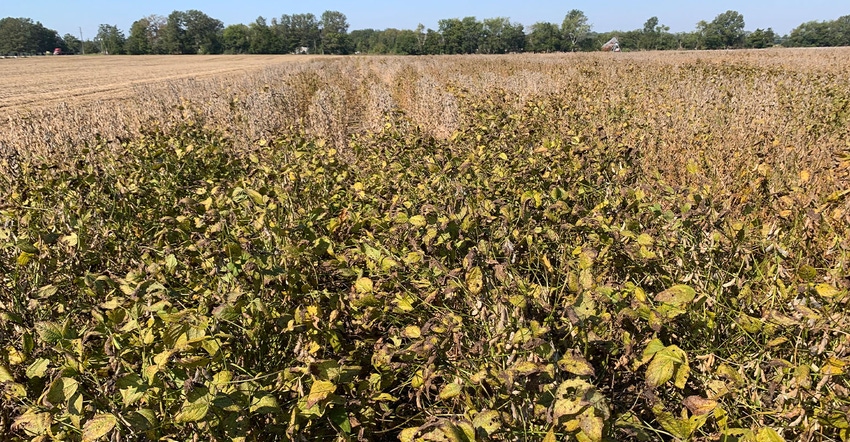
Green stem can oftentimes significantly affect soybean harvest by making harvesting more labor-intensive. There are numerous possible causes of green stem, making it hard to pinpoint a possible solution.
Tom Allen, Extension and research plant pathologist for Mississippi State University stationed in Stoneville, Miss., discussed causes of green stem as well as management considerations, during the online Louisiana Agricultural Technology & Management Conference.
Green stem symptom expression
There are several names related to delayed senescence in soybean, commonly known as green stem. A few other names include green bean syndrome, green plant malady, green stem malady, green stem disorder, green stem syndrome, greening effect, and stay-green.
"There are several factors that may be related or allow soybean plants to express green stem such as insect feeding, herbicide application, fungicides, and plant diseases," Allen said. "When it comes to the symptoms expressed, what is observed in the field? As you would expect from the name, we see green stems as well as varying degrees of foliage that remain on the soybean plants at harvest."
Typically, plants with green stem still have foliage present, but the pods are at maturity and ready to be harvested.
"In a lot of cases, some fields with green stem are harvested," he said. "Although, I think we all have seen plenty of soybean fields at harvest time where a portion of the field was left because it was too green to harvest. One symptom I do want to point out in the case of severe green stem is severe pod set issues. You may have quality issues whereby some pods will just do nothing but rot in the field. I saw a tremendous amount of cases like that in 2020.
"There are a lot of possible factors reported to contribute to green stem. Angus Catchot and I were discussing this, and he indicated how, in the years he has been an entomologist in this state, he doesn't recall a single instance where he saw an entire field of green stem, which was the result of insect feeding."
In observations, the redbanded stink bug, which is a bit more aggressive than other stinkbugs, can relate to green stem in some instances.
"Herbicides, such as glyphosate, may also increase green stem," Allen said. "When it comes to fungicides, you can observe some differences between products. One thing to point out is that any fungicide application containing any active ingredient can relate to an increase in green stem when compared to a field that was not treated with a fungicide.
"Going back to 2016 research on fungicides, regardless of what the product was or the particular active ingredient or if it was a premix fungicide product containing more than one mode of action or even a tank mix, there was an increase in observable green stem."
Diseases can also increase occurrences. Cercospora blight and bean pod mottle virus (BPMV) have both been implicated in the expression of green stem.
Other possible causes
Additional factors that may contribute to green stem include variety differences, environmental factors, and plant stress.
"Insect feeding, herbicides, fungicides, and diseases are our known factors for green stem," Allen said. "We are fully aware that some of those can relate to the amount of green stem we observe in any given field of soybean. However, there are likely some additional factors that can contribute to this problem."
The environment is one additional factor that can contribute to the production of green stem.
"This is one where farmers and consultants sometimes shake their heads at plant pathologists because this is not something we can always control," he said. "However, the environment can have a tremendous impact on something like green stem."
From research on varieties, environmental factors seemed to be a key cause for more instances of green stem as shown from the different location results captured during the 2020 season.
"There are incredible differences in the amount of green stem as it relates to differences in variety," Allen said. "Of course, plant stress is another possibility. For example, the lack of irrigation during a dry year could factor into how stress could impact the plants."
Looking at 41 varieties contained in the maturity group IV early Xtend varieties as a part of the Mississippi State University Variety Testing program, there were major differences in the amount of green stem present between varieties as well as between locations containing the same varieties.
"One thing we are considering in our research is how the environment impacts those varieties and the difference in green stem between locations," he said. "Because looking at the same varieties across multiple locations, does not necessarily show the same results."
Management considerations
When it comes to management considerations, there are a few considerations to aid in reducing green stem.
"Examine possible varieties that don't present a lot of green stem as shown in unbiased plot trials," Allen said. "Also, consider if a fungicide is necessary for every situation since most fungicides, if not all fungicide active ingredients, have the ability to allow plants to produce green stem."
Another difficult factor to manage is plant stress.
"Stress can be a lot easier to manage in an irrigated situation than it can be a non-irrigated situation," Allen said. "Also, Paraquat + sodium chloride is always an option in situations where green stem may slow down harvest, but that is one of those things that depends upon where you are to whether or not that will work on your farm."
About the Author(s)
You May Also Like




